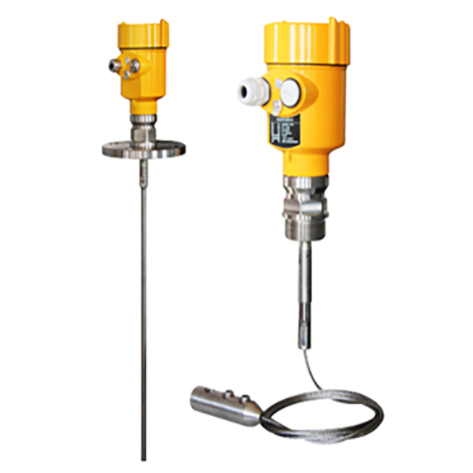BETTER TOUCH BETTER BUSINESS
Contact Sales at KAIDI.
Radar type level transmitter is well known for their accuracy and effectiveness in measuring levels. They find use in industries such as petroleum, power plants and chemical processing as they greatly contribute to efficiency and safety. These transmitters operate based on the Time of Flight (TOF) principle. Can be divided into two categories; contact type radar level transmitters and non-contact type radar level transmitters.
Contact type radar level transmitters consist of a transmitter connected to a probe that includes an antenna and a microprocessor. The antenna emits radar waves into the tank through the guiding probe. As these waves encounter the material, inside the tank some of them reflect back while others continue traveling towards the bottom of the tank.
The remaining radar waves hit the bottom of the tank. Bounce back, to the transmitter creating an echo waveform. This echo waveform is crucial in determining the level of liquid or material inside the tank.
Non contact type radar level transmitters are simpler and consist of an antenna and a microprocessor. The antenna sends out radar waves into the tank, which then bounce back after hitting the material. The microprocessor calculates the distance by considering how long it takes for the radar waves to travel and knowing their speed.
While non-contact radar level transmitters have advantages like installation, they do suffer from signal loss compared to guided wave radar transmitters. This signal loss happens because electromagnetic radiation tends to disperse into space. Guided wave radar transmitters solve this problem by using a probe that directs radio energy along a path. When using radar level transmitters it's important to consider the dielectric constant of the material being measured. For measurements there should be a difference, in dielectric constant typically ranging from 5 to 8 units. If this condition isn't met the radar will fail to generate an echo.

The applications of radar level transmitters are diverse and essential in industries. These versatile and precise instruments have proven their worth providing measurements and durability. Let's explore some areas where radar level transmitters are commonly used;
In the petrochemical and chemical sectors radar level transmitters excel at measuring types of liquids stored in tanks and vessels including chemicals and solvents. Their ability to withstand environments ensures the handling of volatile substances.
Radar level transmitters are crucial for monitoring water levels in steam boilers, condensate tanks and cooling towers within power plants. Accurate measurements play a role in maintaining steam generation while preventing potential equipment damage.
The food and beverage industry relies on radar level transmitters to measure levels in storage tanks. This helps ensure product quality by preventing overflows during production processes.
Radar level transmitters play a role, in monitoring water levels in reservoirs, sewage treatment plants and stormwater management systems. They facilitate water resource management while helping prevent flooding incidents.
Mining operations often involve the handling of materials including ores, slurries and tailings. Radar level transmitters play a role in measuring material levels in storage silos and tanks. This helps ensure material handling and reduces downtime.
In the pulp and paper industry radar level transmitters are used to measure levels of pulp and paper stock in storage tanks and paper machines. Precise level measurements are essential for maintaining product quality and minimizing production interruptions.
The pharmaceutical industry heavily depends on radar level transmitters to ensure measurement of liquids and chemicals in processing and storage tanks.
These examples highlight a few of the applications where radar level transmitters play an integral role. Radar level transmitters have become extremely valuable, across industries due to their ability to provide accurate and reliable level measurements in challenging conditions.
Radar level transmitters offer benefits that have contributed to their widespread adoption in different industries;
Suitable for Corrosive Liquids; Non-contact radar level transmitters are particularly effective for liquids, making them well suited for demanding industrial environments.
Versatility; These transmitters can measure levels of liquid, solid, slurry or interfaces providing flexibility for a range of applications.
Low Maintenance Requirements; Since radar level transmitters do not have moving parts, maintenance needs are minimal. This reduces downtime and operational costs.
Resistance to Factors; Measurements remain unaffected by variations in density, temperature and pressure.
Accuracy & Responsiveness; Compared to measurement technologies radar type level transmitter offer accuracy and responsivenes, ensuring accurate monitoring.
Despite their advantages, engineers and operators should consider the following limitations associated with radar type level transmitter;
Permittivity Sensitivity; Readings can be influenced by changes, in the permittivity of the material being measured which may lead to inaccuracies.
Cleaning and Maintenance; When using radar transmitters it's important to keep in mind that if any material sticks, to the probe it can cause echoes and lead to faulty measurements. To avoid this, cleaning and maintenance of the probe are necessary.
Interference Measurements; For measurements of interface echoes there should be a difference in the dielectric constant (around 5 to 8 units). If the difference is not significant enough there might be issues with measuring interface echoes.
Installation and Troubleshooting; Installing and troubleshooting radar type level transmitters requires training and proprietary software. This adds complexity to the process.
Calibration Challenges; Calibrating radar level transmitters can be a procedure that demands attention to detail in order to achieve accurate measurements.
Radar level transmitters have brought advancements in level measurement across various industries due to their accuracy, versatility and ability to withstand environmental conditions. Whether its monitoring levels at power plants or managing chemical storage tanks these transmitters provide a solution.
However, understanding their limitations and implementing proper installation and maintenance practices is crucial for making the most out of their capabilities. With improvements in radar technology, these transmitters are expected to continue playing a role in ensuring operational efficiency and safety across diverse industrial settings.
We are here to help you! If you close the chatbox, you will automatically receive a response from us via email. Please be sure to leave your contact details so that we can better assist